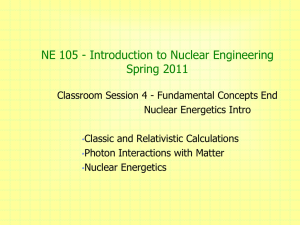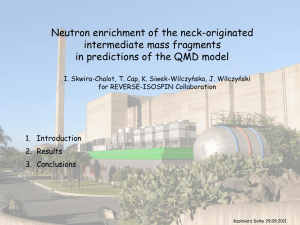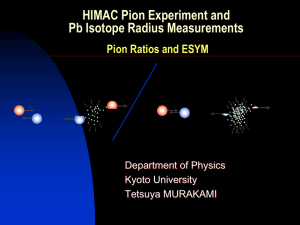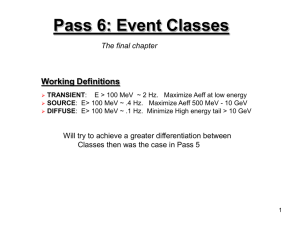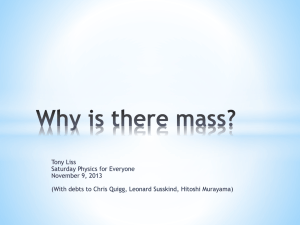Wasi
advertisement
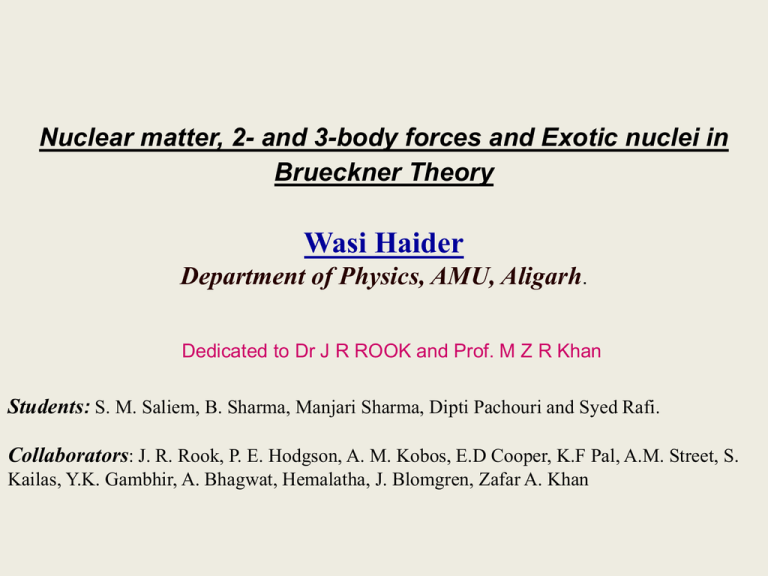
Nuclear matter, 2- and 3-body forces and Exotic nuclei in Brueckner Theory Wasi Haider Department of Physics, AMU, Aligarh. Dedicated to Dr J R ROOK and Prof. M Z R Khan Students: S. M. Saliem, B. Sharma, Manjari Sharma, Dipti Pachouri and Syed Rafi. Collaborators: J. R. Rook, P. E. Hodgson, A. M. Kobos, E.D Cooper, K.F Pal, A.M. Street, S. Kailas, Y.K. Gambhir, A. Bhagwat, Hemalatha, J. Blomgren, Zafar A. Khan 1. Introduction (a) Brief sketch of the theory of Nuclear Matter (effective Interaction) (b) Self consistency (BHF) 2. Binding Energy (symmetric ) (a) Two body force (Coester Band) (b) Three-body force (TBF) (c) Results 3. Nucleon Optical potential (a) Results (Recent) 4. EXOTIC Nuclei. 5. Summary Introduction (a) Brief sketch of the theory of Nuclear Matter (effective interaction/G-matrix) Relationship of Nuclear Matter with Nuclear Physics (NP): Main Aim of NP To understand Nuclear Structure in terms of n/p and the strong force among the constituents. One should start from some fundamental Theory- derive the existence and Properties of real nuclei NO SUCH THEORY… Non-Relativistic Schrödinger Eqn. for n/p interacting via the Realistic TWO-Body force (approx.) +3-body force. THIS MANY-BODY PROBLEM IS TOO HARD TO SOLVE Nuclear matter (NM) enters as simple FIRST STEP NM is a HYPTHETICAL SYSTEM : No Coulomb force Equal no. of n/p. INFINITE in Coordinate space. Translational Invariance… SPWF = Plane Waves ONLY problem to solve… E/A as f (ρ) and the effective Interaction Saturation Property of Nuclear Force.. E/A(ρ) minimum E0 at ρ0 . Empirical Estimates of NM Prop E0 = -16 ± 1 (MeV) , K= 210 ± 30, 0 = 0.17 ± 0.01 Nucl./fm-3 S= 30.0 ± 3 (MeV) Nuclear Matter theory with TWO-Body force should predict the above properties Nuclear EOS Attempt to obtain EOS & OMP from basic Theory (NM) (a) BHF (b) Variational (c) DBHF (Bethe, Brueckner, Gammel, Rajaraman, B. D. Day) Rev. Mod. Phys. 39(1967)719, Rev. Mod. Phys. 39(1967)745. Rajaraman & Bethe(Three Nucleon Correlations) Only input is: NN-interaction + Nucleon Density in Target Nuclei Φ0 = 1/√A! A [ Φ1(r1)Φ2(r2)……..ΦA(rA) ] H0 Φ0 = E0 Φ0, where E0 =∑En HΨ=EΨ Goldstone expansion for E E = E0 + <Φ0 ׀H1 ׀Φ0 > +< Φ0 ׀H11/ (E0-H0) ΡH1 ׀Φ0> + …. where P = 1 - Φ0> <Φ0 FIRST ORDER TERMS: 2000 Av-18 1500 V(r) (MeV) 1 S0 1000 500 This would diverge as v is highly repulsive at short distances. 0 0.0 This is like first Born term: Full Schrodinger equation 0.5 1.0 1.5 r(fm) 2.0 2.5 mn v mn + m n v ab ab v m n E a Eb E m E m + mn v cd cd v ab ab v mn + ….. Ec Ed Em En Ea Eb Em En Ψrs(r1,r2) = Φrs(r1,r2) - (Q/e) G(W) Φrs(r1,r2). vΨrs(r1,r2) = (v - v (Q/e) G(W) ) Φrs(r1,r2) = G(W) Φrs(r1,r2). Ψrs(r1,r2) = Φrs(r1,r2) - (Q/e) v Ψrs(r1,r2) This is the famous Bethe-Goldstone integral equation. Summary The sets of equations suggest that the single particle potential has to be calculated in a self consistent manner. The above choice is called as the Brueckner-Hartree-Fock approximation (BHF). The BINDING ENERGY of NUCLEAR MATTER is then The figure shows the level of self- consistancy achieved in about 4-5 cycles (Av-18) Results: No TWO-BODY force gives the correct Saturation property of the Symmetric Nuclear Matter. The Goldstone expansion converges rapidly. Hence there is no hope that higher order terms would improve this situation. • THREE-Body forces are introduced to remedy this situation. = N N N , N N , N N + + N N N N* N N N A. Lejeune, U. Lombardo, and W. Zuo, Phys. Lett. B 477, 45(2000); URBANA MODEL NPA 401, 59 (1983) NPA 449, 219 (1986) We need to calculate VS(r), VT(r) and VR(r) and the corresponding defect functions. -1 R kF= 1.4 fm A =- 0.0058 U = 0.0016 V (r) 6 4 V (MeV) 2 VT(r) 0 -2 VS(r)/5 -4 -6 -8 0.0 0.5 1.0 1.5 2.0 2.5 r(fm) 0.8 -1 KF=1.1 fm 1 S0 0.6 -1 KF=1.33 fm -1 KF=1.4 fm -1 0.4 KF=1.5 fm g(r) -1 KF=2.0 fm 0.2 0.0 -0.2 0 1 2 3 -1 r(fm ) 4 5 Pure neutron Matter: Symmetry Energy at normal density from Results: different NN-interactions are nearly same and close to the expected result of about 30 NEUTRON MATTER(TBF) MeV. 70 800 UV14+TNI BHF(OUR) UV14+TBF(OUR) UV14+TBF(VARITAIONAL) UV14+TNI(VARITAIONAL) AV14+TBF BHF(BALDO) 700 50 500 ES(MeV) E()(MeV) 600 UV14 UV14+UVII UV14+TNI 60 400 40 30 300 200 20 100 10 0 0.0 0.2 0.4 0.6 0.8 1.0 1.2 -3 density(fm ) 1.4 1.6 1.8 2.0 0 0.0 0.1 0.2 0.3 -3 density(fm ) 0.4 0.5 104 mass density 103 3 MeV-fm pressure UV14+TNI UV14+TBF UV14 102 c 101 sound velocity c/10 100 0.0 0.5 1.0 density(fm-3) 1.5 2.0 Nuclear optical Potential Nucleon Scattering has provided a huge wealth of information about nuclear interaction This Interaction is represented as a single Particle Potential (OPTICAL POTENTIAL): U(E,r)=-V(E,r)-iW(E,r)+Vc(r) +(Vso(E,r) + iWso(E,r)) Empirically different components are represented in terms of a large no of parameters ( normally 12) It has helped in organizing huge data set, however, there are ambiguities and very small predictive power of this model: DATA: (p,n) Elastic, Reaction & Total cross-section, Polarisation, Spin-Rotation Non Relativistic Mod works upto 200 MeV (A=12-208) Hence the quest to determine it Microscopically starting from the basic NNinteraction using some theory (BHF). BHF: 1. AMOS-Group (Non-Local: Bonn) 2. Our-Group (Local: HJ, UV14, Av-14, Av18, Reid93, Nijm II) We solve the radial Bethe Goldstone equation U JS LL' (kr ) j (kr ) L LL' 4 L' ' 0 G (r, r ' ) v L' JS L' L' ' (r ' ) U JS LL' ' Use BR prescription to define radial G-matrices such that the NM-potential is reproduced. < Φrs g Φrs > = < Φrs v Ψrs > 2 (r ' )r ' dr' The G-matrices are folded over the nucleon densities to obtain the central and spin-orbit components of the OMP. n Uc (r1 , E ) = nn np n (r2 ) g D ( r1 r2 , ( R), E )dr2 p (r2 ) g D ( r1 r2 , ( R), E )dr2 nn ( r , r ) g ( r r , ( R ), E ) j ( k r r2 )dr2 o n 1 2 EX 1 2 1 np p (r1 , r2 ) g EX ( r1 r2 ), ( R), E ) jo (k r1 r2 )dr2 30 Av 18 40 Ca Ca 0 Imaginary Central Potential (MeV) 20 40 Real Central Potential (MeV) 10 0 -10 21MeV 26 30 40 45 50 65 75 85 95 107 127 155 185 225 400 -20 -30 -40 -50 -10 21MeV 26 30 40 45 50 65 75 85 95 107 127 155 185 225 400 -20 -30 -60 0 2 4 6 8 0 2 r (fm) The real and imaginary central parts for p-40Ca (21-400 MeV) 4 r (fm) 6 8 1.0 Sn isotopes at 50MeV using Uv-14+UVII 0.20 96 0.15 0.10 Ep=200 MeV 0.05 0.00 Real Spin Orbit Potential (Mev) Peak Value (Real Spin-orbit) (MeV) Sn 0.5 96 Sn Sn 100 Sn 102 Sn 104 Sn 106 Sn 108 Sn 110 Sn 112 Sn 114 Sn 116 Sn 118 Sn 120 Sn 122 Sn 124 Sn 126 Sn 128 Sn 130 Sn 132 Sn 98 132 Sn 0.0 p-Sn (96-136) Isotopes 92 96 100 104 108 112 116 120 124 128 132 136 140 A -0.5 0 2 4 6 8 10 r (fm) Decrease of spin-orbit potential as more and more neutrons are added to a nucleus. Predicted weakening of the Spin-Orbit interaction with the addition of Neutrons; M.Hemalatha,Y.K.Gambhir,W.Haider and S.Kailas. Phys. Rev. C79(2009)057602 12 Proton scattering from Sn-Isotopes at 295 MeV Microscopic description of 295 MeV polarized protons incident on Sn isotopes. W. Haider, Manjari Sharma, Y. K. Gambhir, and S. Kailas, Phys. Rev. C 81, 034601 (2010). Proton scattering from Pb-isotopes at 295 MeV PHYSICAL REVIEW C 84, 037604 (2011) Microscopic description of proton scattering at 295 MeV from Pb isotopes Syed Rafi, Dipti Pachouri, Manjari Sharma, A. Bhagwat, W. Haider, and Y. K. Gambhir The first maxima in the spin-orbit force for p-Ni isotopes (52-114) at 65 MeV. The inset shows the neutron skin for the same isotopes. J. Phys. G: Nucl. Part. Phys. 40 (2013) 065101 Syed Rafi, A Bhagwat, W Haider and Y K Gambhir 2.2 Ca Isotopes using Av18+3BF at 65MeV 36 Ca Ca 40 Ca 42 Ca 44 Ca 46 Ca 48 Ca 50 Ca 52 Ca 54 Ca 56 Ca 58 Ca 60 Ca 62 Ca 64 Ca 66 Ca 68 Ca 70 Ca 72 Ca 74 Ca 76 Ca 78 Ca 80 Ca 82 Ca 84 Ca 38 2.0 Real Spin Orbit Potential(MeV) 1.8 1.6 36 1.4 Ca 1.2 1.0 84 0.8 Ca 0.6 0.4 0.2 0.0 0 1 2 3 4 5 r(fm) 6 7 8 9 Exotic Nucleus: 22C -1 10 P(r) N(r) P(r) N(r) 0.07 0.06 22 22 C C 3 Density(Nucleon/fm ) Recent Reaction Cross-Section. Results for p- 22C at 40 MeV. K. Tanaka et al. PRL 104 (2010)062701. 19C………..754(22) mb 20C………..791(34) mb 22C………..1338(274) mb Our Brueckner Theory + Glauber Theory results: 22C……1334 mb Only extended density for the last two neutrons give results in excellent agreement with data. 0.05 0.04 -2 10 0.03 0.02 Indicating a Halo structure for 22C 0.01 -3 0.00 10 0 1 2 3 4 5 r (fm) 6 7 8 0 1 2 3 4 5 r (fm) 6 7 8 The nucleus: 6He The recent data on polarisation of protons from 6He at 71 MeV analysed in BHF. The extended neutron density distribution suggests a HALO structure. -1 10 6 He P(r) N(r) -2 10 -3 10 -4 10 0 2 4 r (fm) 6 8 The nucleus: 9C Li Isotopes PHYSICAL REVIEW C 86, 034612 (2012) Syed Rafi, A. Bhagwat,W. Haider and Y. K. Gambhir Nucleon Optical potential with Three-Body forces p-40Ca at 65 MeV p-40Ca at 200 MeV PHYSICAL REVIEW C 87, 014003 (2013) Syed Rafi,Manjari Sharma,Dipti Pachouri,W. Haider,and Y. K. Gambhir List of recently published research papers in refereed journals : 1. Microscopic Optical Model Potentials for p-Nucleus Scattering at Intermediate Energies, M.Hemalatha, Y.K.Gambhir, S.Kailas and W.Haider Phys.Rev.C75(2007)037602 2. Elastic scattering of 96 MeV neutrons from iron, yttrium and lead; A.¨Ohrn, J. Blomgren, P. Andersson, A. Atac, C. Johansson…+ Phys. Rev. C77(2008)024605 W.Haider; 3. Predicted weakning of the Spin-Orbit interaction with the addition of Neutrons; M.Hemalatha,Y.K.Gambhir,W.Haider and S.Kailas. Phys. Rev. C79(2009)057602 4. Microscopic Local Optical Potentials and the Nucleon Nucleus Scattering at 65 MeV. W. Haider, Manjari Sharma, IJMPE Vol.19, No 3 465-482 (2010). 5. Microscopic description of 295 MeV polarized protons incident on Sn isotopes. W. Haider, Manjari Sharma, Y. K. Gambhir, and S. Kailas, Phys. Rev. C 81, 034601 (2010). 6. Neutron density distribution and the halo structure of 22C. Manjari Sharma, A. Bhagwat, Z. A. Khan, W. Haider, and Y. K. Gambhir Phys. Rev C 83, 031601(R) (2011). 7. Microscopic description of protons scattering at 295 MeV from Pb isotopes. Syed Rafi, Dipti Pachouri, Manjari Sharma, Ameeya Bhagwat, W. Haider and Y. K. Gambhir, Phys. Rev. C 84, 037604 (2011). 8. Microscopic Neutron optical potential in the energy region 65-225MeV. Syed Rafi and W.Haider International Journal of Modern Physics E Vol. 20, No. 9 (2011) 2017–2026. 9. Microscopic Optical Potential from Argonne inter-nucleon potentials. Dipti Pachouri, Manjari Sharma, Syed Rafi, W. Haider International Journal of Modern Physics E; Vol.20, No.11 (2011)2317-2327. 10. Exact calculation of the Direct part of the nucleon-nucleus spin-orbit potential in Brueckner theory; Dipti Pachouri, Syed Rafi, Manjari Sharma and W.Haider; International Journal of Modern Physics E Vol. 21, No. 2 (2012) 1250010. 11. Microscopic optical potentials for nucleon - nucleus scattering at 65 MeV. Dipti Pachouri, Syed Rafi, W Haider Journal of Physics G: Nuclear and Particle Physics J. Phys. G: Nucl. Part. Phys. 39 (2012) 055101 (18pp) 12.Brueckner-Hartree-Fock based optical potential for proton- 4,6,8He and proton- 6,7,9,11Li scattering Syed Rafi, A. Bhagwat, W. Haider, Y.K.Gambhir Phys.Rev. C 86, 034612 (2012) 14. Equation of state and the nucleon optical potential with three-body forces Syed Rafi, Manjari Sharma, Dipti Pachouri, W. Haider and Y. K. Gambhir Phys.Rev. C 87, 014003 (2013). 15. A systematic analysis of microscopic nucleon–nucleus optical potential for p–Ni scattering Syed Rafi, A Bhagwat2, W Haider and Y K Gambhir J. Phys. G: Nucl. Part. Phys. 40 (2013) 065101 Thank You
